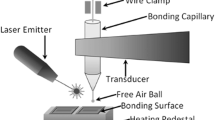Abstract
Copper is nowadays replacing the traditional gold in wire bonding interconnections, due to lower cost, better thermal/electrical properties and reliability performances. The increased hardness of Cu imposes higher bonding force and ultrasonic power during the wire-bonding process, increasing the risk of stress-induced bondpad damage. The aim of the presented work has been the modeling and characterization of stress and deformations resulting from the ball-bonding phase in order to have a quantitative method able to optimize the process set-up and the manufacturing capabilities already at design level. A finite element model has been developed and benchmarked with experimental samples obtained by freezing the ball bonding process at different steps, on which the deformations occurred in the bonded copper ball and in the bondpad layers have been measured through Xe plasma focused ion beam (Plasma-FIB) cross sections.











Similar content being viewed by others
References
Hsu, H.C., Chin, P.C., Hu, C.Y., Chang, W.Y., Yeh, C.L., Lai, Y.S.: Dynamic analysis on underlay microstructure for cu/low-k wafer during wire bonding. In: Key Engineering Materials, vol. 419, pp. 489–492. Trans Tech Publ (2010)
Hang, C., Wang, C., Mayer, M., Tian, Y., Zhou, Y., Wang, H.: Growth behavior of cu/al intermetallic compounds and cracks in copper ball bonds during isothermal aging. Microelectron. Reliab. 48(3), 416–424 (2008)
Durand, C., Klingler, M., Coutellier, D., Naceur, H.: Power cycling reliability of power module: a survey. IEEE Trans. Device Mater. Reliab. 16(1), 80–97 (2016)
Kim, H.J., Lee, J.Y., Paik, K.W., Koh, K.W., Won, J., Choe, S., Lee, J., Moon, J.T., Park, Y.J.: Effects of cu/al intermetallic compound (IMC) on copper wire and aluminum pad bondability. IEEE Trans. Compon. Packag. Technol. 26(2), 367–374 (2003)
Tan, C., Pan, Y., Cheok, T.: Copper wire bonding-elimination of pad peel. In: 2016 IEEE 18th Electronics Packaging Technology Conference (EPTC), pp. 129–134. IEEE (2016)
Lall, P., Luo, Y., Nguyen, L.: De-bonding simulation of cu-al wire bond intermetallic compound layers. In: 2016 15th IEEE Intersociety Conference on Thermal and Thermomechanical Phenomena in Electronic Systems (ITherm), pp. 862–870. IEEE (2016)
Albrecht, J., Auersperg, J., Reuther, G., Kudella, P., Brueckner, J., Rzepka, S., Pufall, R.: Brittle fracture and damage in bond pad stacks-a study of parameter influences in coupled xfem and delamination simulation of nanoindentation. In: 2016 IEEE 18th Electronics Packaging Technology Conference (EPTC), pp. 724–728. IEEE (2016). https://doi.org/10.1109/EPTC.2016.7861577
Calabretta, M., Sitta, A., Oliveri, S.M., Sequenzia, G.: Structural characterization of semiconductor multi-layer pad. In: Proceedings of the Institution of Mechanical Engineers, Part C: Journal of Mechanical Engineering Science p. 09544062211000777 (2021). https://doi.org/10.1177/09544062211000777
Amro, R., Lutz, J., Rudzki, J., Sittig, R., Thoben, M.: Power cycling at high temperature swings of modules with low temperature joining technique. In: 2006 IEEE International Symposium on Power Semiconductor Devices and IC’s, pp. 1–4. IEEE (2006)
Bayerer, R., Herrmann, T., Licht, T., Lutz, J., Feller, M.: Model for power cycling lifetime of igbt modules-various factors influencing lifetime. In: 5th International Conference on Integrated Power Electronics Systems, pp. 1–6. VDE (2008)
Lutz, J., Franke, J.: Reliability and reliability investigation of wide-bandgap power devices. Microelectron. Reliab. 88, 550–556 (2018). https://doi.org/10.1016/j.microrel.2018.07.001
Scheuermann, U., Schmidt, R.: Impact of load pulse duration on power cycling lifetime of al wire bonds. Microelectron. Reliab. 53(9–11), 1687–1691 (2013). https://doi.org/10.1016/j.microrel.2013.06.019
Czerny, B., Khatibi, G.: Accelerated mechanical fatigue interconnect testing method for electrical wire bonds. TM-Technisches Messen 85(4), 213–220 (2018)
Chen, J., Degryse, D., Ratchev, P., De Wolf, I.: Mechanical issues of Cu-to-Cu wire bonding. IEEE Trans. Compon. Packag. Technol. 27(3), 539–545 (2004)
Bai, X., Chang, B., Du, D.: Influences of material and structural factors on the stress conditions in cu/low-k chips during cu wire bonding. In: 2014 15th International Conference on Electronic Packaging Technology, pp. 441–446. IEEE (2014)
Liu, Y., Irving, S., Luk, T.: Thermosonic wire bonding process simulation and bond pad over active stress analysis. IEEE Trans. Electron. Packag. Manuf. 31, 61–71 (2008). https://doi.org/10.1109/TEPM.2007.914232
Shen, L., Gumaste, V., Poddar, A., Nguyen, L.: Effect of pad stacks on dielectric layer failure during wire bonding. In: 56th Electronic Components and Technology Conference 2006, pp. 6–pp. IEEE (2006)
Meyer, T., Unger, A., Althoff, S., Sextro, W., Brökelmann, M., Hunstig, M., Guth, K.: Modeling and simulation of the ultrasonic wire bonding process. In: 2015 IEEE 17th Electronics Packaging and Technology Conference (EPTC), pp. 1–4. IEEE (2015)
Schemmel, R., Krieger, V., Hemsel, T., Sextro, W.: Co-simulation of matlab and ansys for ultrasonic wire bonding process optimization. In: 2020 21st International Conference on Thermal, Mechanical and Multi-Physics Simulation and Experiments in Microelectronics and Microsystems (EuroSimE), pp. 1–11. IEEE (2020)
Shah, A., Mayer, M., Zhou, Y., Hong, S., Moon, J.: In situ ultrasonic force signals during low-temperature thermosonic copper wire bonding. Microelectron. Eng. 85(9), 1851–1857 (2008)
Shen, N., Samanta, A., Ding, H., Cai, W.W.: Simulating microstructure evolution of battery tabs during ultrasonic welding. J. Manuf. Process. 23, 306–314 (2016)
Siddiq, A., El Sayed, T.: Acoustic softening in metals during ultrasonic assisted deformation via CP-FEM. Mater. Lett. 65(2), 356–359 (2011)
Shah, A., Mayer, M., Qin, I., Huynh, C., Zhou, Y., Meyer, M.: Ultrasonic friction power during thermosonic Au and Cu ball bonding. J. Phys. D Appl. Phys. 43(32), 325301 (2010)
TMX 7510-6410-5010. Datasheet, Vision Research, Wayne, NJ, USA (2021). www.phantomhighspeed.com/products/cameras/tmx/7510
Author information
Authors and Affiliations
Corresponding author
Ethics declarations
Conflict of interest
The authors declare that they have no conflict of interest.
Additional information
Publisher's Note
Springer Nature remains neutral with regard to jurisdictional claims in published maps and institutional affiliations.
Rights and permissions
About this article
Cite this article
Calabretta, M., Sitta, A. A novel integrated approach to optimize copper wire bonding processes and manufacturing. Int J Interact Des Manuf 16, 371–379 (2022). https://doi.org/10.1007/s12008-022-00844-x
Received:
Accepted:
Published:
Issue Date:
DOI: https://doi.org/10.1007/s12008-022-00844-x



